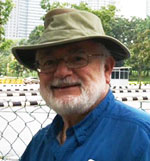By Oliver B. Pollak

SAN FRANCISCO — Erica Peters, author of San Francisco, A Food Biography (2013) and Appetites and Aspirations in Vietnam Food and Drink in the Long Nineteenth Century (2012), gave a presentation at San Francisco’s three-year-old, gorgeously designed, American Bookbinders Museum in the Yerba Buena district, wedged in between Clementina and Folsom Streets. Her topic, “A Cosmopolitan City and Its Cookbooks.” Peters is the director of the Culinary Historians of Northern California.
Peters featured 21 illustrative and illustrious examples among which five were Jewish, two Mexican and three Asian. Over two thirds were written by women. There are hundreds of the Bay Area cookbooks, but Erica only had an hour. Chilies and soy sauce permeate San Francisco cookbooks.
Cookbooks are vital evidence of national, ethnic, and religious communities, and the female power structure within a larger urban environment. And of course they track the changes in tastes, styles and aspirations of home cooking.
The audience of 16 were knowledgeable foodies, cookbook connoisseurs, food professionals, and cookbook writers.
The oldest cook book, California Recipe Book, dated from 1872 (the two-word “cook book” gradually became one word by 1970). Old recipe books provided the ingredients and the amounts, but not the process of preparation. It was assumed meal preparers were sufficiently experienced to figure that out. The year 1872 also saw the publication of How to Keep a Husband, or Culinary Tactics. The Settlement Cook Book by Mrs. Simon Kander first appeared in 1901 and sometimes included a dustjacket declaring, “The way to a man’s heart.”
Special events cookbooks included the 1906 Refugee’s Cook Book for the earthquake and fire; the 1915 Panama Pacific International Cook Book and 1939 World’s Fair, and Alcatraz Island Women’s Club.
The first Jewish cookbook in America dates from 1888 when the women of Denver’s Temple Emanuel produced The Fair Cookbook. The genre expanded slowly as women sought to educate, expand their prominence, and raise money for worthy causes. San Francisco’s first Jewish cookbook appeared in 1909. The members of the Council of Jewish Women, organized in 1893, were predominantly German Reform in background. It had recipes for oysters, lobster, crab, mussels, and clams, indicating rejection of kashrut in favor of assimilation.
Soup to Nuts: Cook Book of Epicures was published by Temple Emanu-El Sisterhood in 1931. The three ring binder, with mimeographed pages, was a depression-era cookbook. It included locally popular Mexican, guacamole, tamale, chop suey, and ramekin recipes.
This patriotic red, white and blue covered Kitchen Strategy, vitamin values made easy by Edith Green & Dr. Leona Bayer published the war time cookbook in 1943. They focused on vitamins, values, and how to feed the family under home front war time conditions. Edith’s roots go back to her German Jewish gold rush father. In 1949 Edith produced a cooking television program on KRON. Julia Childs debuted on TV in 1963. Erica Peters’ grandmother made chopped chicken livers for which this volume has a recipe.
In 1987 Congregation Sha’ar Zahav published Out of our kitchen Closets, San Francisco’s Gay Jewish Cooking. The congregation was established in 1977. It included several chicken soup recipes, somewhat unusual for congregational cookbooks. The recipes were a mixture for Jewish events, gay events and coming out parties. The gay synagogue in Los Angeles dates from 1972, New York 1973, Chicago 1975, and Atlanta in 1985. The first was The Gay Cookbook, by Lou Rand Hogan (pseud for Louis Randall) appeared in San Francisco in 1965.
Joyce Goldstein, the West Coast maven or doyen, of Jewish cookery and chef owner of the Square One Restaurant, has published several commercially successful cookbooks including volumes on Jewish Sephardic and Italian cuisine.
Bay Area foodways reach into novels. I recommend The Cookbook Collector (2010) by Allegra Goodman. You may enjoy the clashing Barnes & Noble and Amazon reader reviews. To cook from these old cookbooks may make a novel or an invitation to disaster. To read them is the joy of history without the mess and calories.
*
Pollak, a professor emeritus of history at the University of Nebraska Omaha, and a lawyer, is a SDJW correspondent now based in Richmond, California. He may be contacted via oliver.pollak@sdjewishworld.com